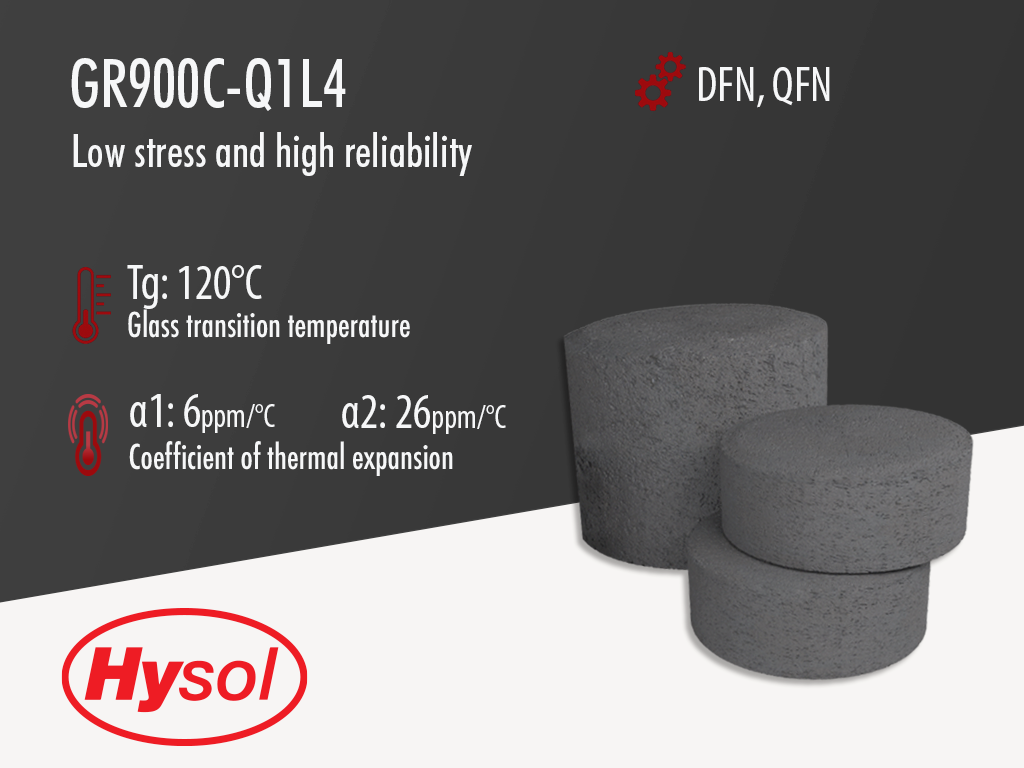GR900 | QFN Epoxy Molding Compound
Harmonization Code : 3907.30.00.40 | Epoxy Mold Compounds containing by weight more than 70 % silicon dioxide
Main features
- Low stress and moisture absorption
- High adhesion
- Low moisture absorption
Product Description
Hysol GR900 is a green molding compound specifically developed for DFN/QFN MSL1 applications. It's designed to provide exceptional performance and reliability. The compound meets the UL94V-0 flammability standard at a thickness of 1/8 inch.
Product Key Features
- Halogen-free
- Low stress — Minimizes stress on delicate electronic components, enhancing long-term reliability.
- High adhesion — Provides a strong bond to the substrate, preventing delamination.
- Low moisture absorption — Reduces the risk of moisture-related defects.
- High reliability — Ideal for demanding applications where durability and performance are critical.
Applications
- DFN/QFNMSL1 Applications
Technical Specifications
| General Properties | |||||||||
| Filler Content | 89 % | ||||||||
| Filler Size Cut | 53 µm | ||||||||
| Specific Gravity Specific Gravity Specific gravity (SG) is the ratio of the density of a substance to the density of a reference substance; equivalently, it is the ratio of the mass of a substance to the mass of a reference substance for the same given volume. For liquids, the reference substance is almost always water (1), while for gases, it is air (1.18) at room temperature. Specific gravity is unitless. | 2.00 | ||||||||
| Electrical Properties | |||||||||
| Volume Resistivity Volume Resistivity Volume resistivity, also called volume resistance, bulk resistance or bulk resistivity is a thickness dependent measurement of the resistivity of a material perpendicular to the plane of the surface. | 4.5x1016 Ohms⋅cm | ||||||||
| |||||||||
| Chemical Properties | |||||||||
| |||||||||
| Physical Properties | |||||||||
| Spiral Flow @ 175°C | 50 cm | ||||||||
| Thermal Properties | |||||||||
| Glass Transition Temperature (Tg) Glass Transition Temperature (Tg) The glass transition temperature for organic adhesives is a temperature region where the polymers change from glassy and brittle to soft and rubbery. Increasing the temperature further continues the softening process as the viscosity drops too. Temperatures between the glass transition temperature and below the decomposition point of the adhesive are the best region for bonding. The glass-transition temperature Tg of a material characterizes the range of temperatures over which this glass transition occurs. | 120 °C | ||||||||
| Thermal Conductivity Thermal Conductivity Thermal conductivity describes the ability of a material to conduct heat. It is required by power packages in order to dissipate heat and maintain stable electrical performance. Thermal conductivity units are [W/(m K)] in the SI system and [Btu/(hr ft °F)] in the Imperial system. | 0.9 W/m.K | ||||||||
| |||||||||
| |||||||||
| Mechanical Properties | |||||||||
| |||||||||
| |||||||||
| |||||||||
| |||||||||
Additional Information
Hysol GR900 Additional Handling Specification
| Property | Value | Unit |
| Preheat Temperature | 70 - 90 | ℃ |
| Molding Temperature | 170 - 185 | ℃ |
| Molding Pressure | 40 - 85 | kg/cm² |
| Transfer Time (Conventional Mold) | 8 - 15 | s |
| Transfer Time (Automold) | 8 - 15 | s |
| Curing Time | 110 - 150 | s |
| Post Cure Time | 4 - 8 | h |



